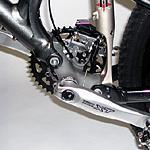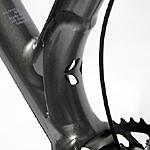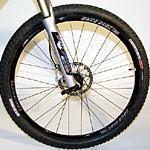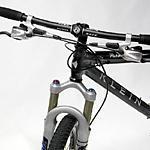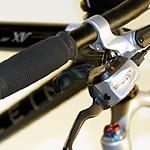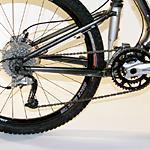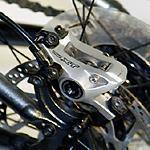
Recently on Cyclingnews.com |
Klein Palomino XV review - June 27, 2004
All-day workhorse
Designed for Going Riding by one of the original suspension pioneers, the Klein Palomino XV might just be the perfect trail bike, says John Stevenson.
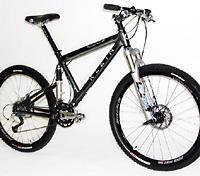
|
You're spoiled for choice. Walk into any high-end mountain bike shop and you're confronted with a huge array of bikes intended for every mountain biking niche: downhilling, 'freeriding', cross-country racing and so on. But what about plain old 'going riding'? It's what most of us actually do, but the marketers have never really got a handle on it. It covers everything from an hour blatting round the local woods, to a long day on the trails, to having a bash at cross-country racing (and especially endurance events). But you see very few bikes specifically intended for just hitting the trails in search of a day's sweaty fun.
The Klein Palomino XV is a bike for going riding, and it's damn good at it. The second-from top of Klein's range of dual suspension mountain bikes, the Palomino XV uses the MonoLink frame design created by Maverick American's Paul Turner. Turner founded RockShox and knows a thing or five about suspension; the MonoLink is his take on a design for going riding.
The Palomino XV features a frame built from Klein's X9000 aluminium tubing with a Maverick shock and aluminium suspension link (if you shell out for one of Maverick American's MonoLink ML7 frames you get a magnesium suspension link and a considerably bigger hole in your wallet). Components come from Shimano's Deore XT group or Klein's sister company Bontrager, which provides just about everything Shimano doesn't make, plus a pair of Bontrager Race Lite Disc tubeless wheels.
Frame & suspension
|
|
|
|
|
The Palomino's MonoLink frame design is one of the more under-stated among suspension mountain bikes, many of which are a confusion of tubes, pivots and shocks that have you wondering where the heck the engine has gone. A tenet of Turner's design philosophy for the original Maverick American ML7 was to keep it looking as much like a regular bike as possible, and that notion has carried through to the Palomino.
The suspension system itself is deceptively simple. The bottom bracket shell sits between a pair of pivots. A rear wheel impact causes the rear subframe to rotate up and back, compressing the shock that's a structural frame member and sits right behind the seat tube. The Maverick American shock is air-sprung and oil-damped, with adjustment for rebound damping.
A few years ago there was a short-lived fad for 'unified rear triangle' bikes - suspension designs where the whole rear triangle including the bottom bracket was part of the rear subframe. The problem with many of these designs was that they worked less well if you stood up, because that moved your weight from the suspended saddle to the unsuspended pedals. The advantage was that chain tension didn't affect the suspension.
In many ways the Palomino's is halfway between a 'conventional' suspension system and a unified rear triangle design, but because there's a pivot either side of the bottom bracket, the suspension still works when you stand. My impression was that it works better when you're seated, but you don't have to make a conscious effort to keep your bum planted on the seat the way you did with unified rear triangle designs.
Up front, the air-sprung Fox Forx F100RLT offers adjustment for rebound damping, and lockout for climbing, with a 'threshold' adjuster that determines when a hit will over-ride the lockout. I have to confess that aside from setting the air pressure for my weight I didn't mess with it much - it worked as I wanted it to, stopping me from going on my face when I got out of my depth a couple of times, so I left it alone.
More than a few times I went into something way too deep and was rescued by the control offered by the F100RLT. It provides good torsional stiffness, accurate tracking and great, supple bump-absorbtion.
Klein's frames have always been known for the quality of their finish and paint, and the Palomino continues the tradition, with big, even welds and dark green pearlescent paint. It's not flashy (to the relief of those who remember the dayglo Kleins of the nineties) but classy and under-stated.
Detailing includes two water bottle mounts, internal gear cable routing, hose attachment points for the rear brake and a bolt-up seat-post clamp. I happen to prefer a quick release for those moments when you really want the saddle out of the way (like cramming the bike into a car!) but that's an easy detail to change at point of purchase.
Wheels
|
|
|
The Bontrager Race Lite wheels and Revolt Super X tubeless tyres surprised me by giving absolutely no problems in four months of riding. I'm skeptical about tubeless systems in a 'what do you do if you get a serious hole in the tyre?' way, but I was impressed with the complete lack of punctures in the test period - I'd have expected a snakebite or two in that time. I was also deeply impressed with the grip and handling of the Revolt X tyres which tracked through everything from loose dust to rock and gravel with aplomb, and hooked up well enough on the few bits of damp surface I managed to find.
Seating & controls
Our size M Palomino came with a 120mm Bontrager Race stem, Bontrager Race flat bar and Klein grips. Under your bum you get a Bontrager FS 2000 saddle and Bontrager Race seatpost. It's all decent, functional stuff. The saddle is the stand-out component for me, in that it's the most comfortable seat I've used in ages. Saddles, though, are intensely personal and what suits me may not suit you. But I liked it a lot.
I also liked the slight extra width of the handlebar - 60cm compared to the 58cm of most flat bars. Add bar ends for cross-country racing and you'd still have plenty of cockpit space. The Klein grips were comfy enough, but a bit narrow for my taste, with only one hand position. I like to be able to move around a bit so I substituted wider Oury Lock-ons for much of this test after a rainy ride caused the original grips to slip off in my hands.
The riding position is very 'cross-country' - no sit-up-and-cruise riser bar rig here. I liked it, but I spend a heck of a lot of time on a road bike so I prefer to a low/forward position.
Components
|
|
|
|
|
The Palomino is hung with an almost-complete 2004 Shimano Deore XT group, and there's therefore a lot to talk about in this area. Shimano has revamped every part of Deore XT, making it once again the component set of choice for those who'd like XTR but really can't justify (or afford) the expense.
Features that have trickled down from XTR include Dual Control shifting, in which the brake lever moves up and down to effect the gear shifts; Hollowtech II crank and bottom bracket with the right and crank and axle permanently joined and oversize, outboard bearings; Low Normal shifting, in which cable pull moves the derailleur to smaller sprockets instead of larger ones; and Mono-Body disk brake calipers where the caliper body is forged in one piece, which Shimano claims increases rigidity and reduces weight. You don't get the Center Lock splined disk rotor, though, because the Palomino's Bontrager Race X Lite wheels that have bolt-on rotors.
Shifting
To deal with the most obvious feature first, the Palomino's gear shifting is excellent, but that's no less than we've come to expect from Shimano. The differences between last year's XT system with its triggers and standard rear derailleur and this kit with Dual Control and Low Normal derailleur are in many ways as much about interface as they are about mechanisms. I suspect that Dual Control, which really doesn't have many compelling advantages over triggers, is Shimano's way of persuading us all to switch to Low Normal derailleurs, which someone at Shimano must believe in passionately as the company is still pursuing it despite lukewarm reaction since its first appearance in 1997.
What's Low Normal all about then? In a conventional system the shift from small to larger sprocket happens when you pull the cable, which in turn involves pressure on the shift lever. Human effort is therefore directly transmitted to the derailleur to move the chain sideways. In a Low Normal system, the human involvement is taken out. You click a trigger and the derailleur's spring tension moves the chain from small to large sprocket, with the assistance of the shaped teeth on the sprockets and matching HyperGlide chain. Shimano's thinking seems to be that taking the human element out of the important shift to lower gears means we're less likely to stuff it up.
Low Normal first appeared as Rapid-Rise in 1998, and while some people who took the time to get used to it loved it, it generally wasn't very popular. After taking the time to get to know the Dual Control/Low Normal configuration of the Palomino, I think I know why.
It took me several months to get fully comfortable with the Dual Control/Low Normal system. Re-educating reflexes conditioned by almost 20 years of mountain biking was a slow and sometimes painful process as I repeatedly went up a gear instead of down. The problem wasn't that I had to push the brake lever up and down - I soon stopped groping for non-existent triggers - but that the tactile feedback wasn't what I was used to. On every other bike I own, pushing against derailleur spring resistance gives a shift to larger sprockets. With the Palomino's Low Normal set-up, resistance equals smaller sprockets. I struggled to adapt.
Nevertheless, I'm sold on the effectiveness of Low Normal shifting. The Palomino never missed a shift, despite being ridden in some fairly silly situations including an eight-hour race at the end of which I could barely stand, never mind think about changing gear. Click the shifter and the derailleur, chain and sprockets do all the work for you. It's great.
I have heard reports of Low Normal giving problems in wet and muddy conditions, but in the one muddy ride I managed (we're in the grip of a 100-year drought in Sydney at the moment) I had no troubles.
Why do I think Low Normal didn't originally take off? Because long-time riders like me have very well-ingrained reflexes that aren't going to adapt in one short test ride, and because even if we like the way the system works, we tend to have more than one bike. Refitting a whole fleet is an expensive proposition.
Once I got used to it, though, I liked both Low Normal and the Dual Control shifters, and as a final small point it's really nice to see a manufacturer speccing Shimano's 11-34 rear cluster to provide the largest possible gear range. You might not need the 34 often, but when you do, it's handy.
Braking
|
The Palomino boasts Shimano's closed-system XT Mono-Body disk brake calipers and levers. They do everything I want a brake to do except for one thing, which I'll get to in a moment.
At the handlebar end the Dual Control brake lever is a fairly bulky affair. In fact, with the levers moved in to my preferred set-up the inboard ends of the levers are just 6cm apart. I may be odd in that I like to hang on to the ends of the lever blades, but back in the days of silly-narrow handlebars this would have been annoying. Fortunately no sane person uses anything much narrower than a 58cm bar these days.
As far as stopping and control goes, these are excellent brakes, with plenty of well-modulated power that's delivered without snatching, grabbing or extraneous noise. For cross-country use, it's hard to imagine a better performer.
I experienced no problems with fade or other niggles except for the slightly startling lifespan of the pads, one of which was worn out after just four months with almost no wet-conditions riding. Call me a tightwad, but I expect to get a bit more life than that from a set of pads. Other Shimano disk users report that this is about usual for Shimano's disk pads, though.
Other bits
|
Other component worth a mention include the new XT cranks, which feature the outboard bottom bracket bearings and over-sized hollow axle permanently mounted to the right hand crank that debuted last year on XTR. It's a terrific piece of design and I'm delighted to see it now available at non-stratospheric prices.
The pedals are more new stuff from Shimano. Over the last couple of years Shimano has redesigned its compact SPD pedals for better mud-shedding, and the M520s are the new, least expensive fruits of the program. They work well, with reliable, easy entry and exit, except for one flukey problem. With the spring tension backed off all the way after an SPD newbie had ridden the bike, I managed to thwack a pedal on a rock and release the springs on one side from their normal position. Subsequent rebuilding was fiddly, to say the least.
On the trail
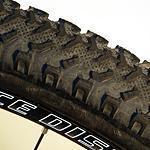
|
The Palomino is a fabulously well-mannered, confidence-inspiring trail bike. It holds lines with aplomb however nasty things get underwheel, and the combination of accurate Fox Forx, Bontrager tyres and predictable rear suspension means it never deals out nasty surprises. Its four inches of travel at each end is plenty for the kind of riding I love, which involves occasional technical challenges, but no hucking, jumping or other potentially bone-breaking silliness. Hey, I'm a 38-year-old with a mortgage...
Where the Klein and I got on really well was whenever the trail pointed upwards. This is a bike that loves to climb, the bobless suspension helping with traction without wasting power and the even handling keeping the front wheel planted and pointing forward. This is a great bike for steep, rough climbs such as the trail out of the valley that separates my house from the best local trails. I cleaned more of it on the Palomino than I've ever managed on my own bikes. The return journey wasn't bad either - this is no 8in travel downhill monster, but it helped me keep in sight a friend who's a much better descender than I am.
My best moments with the Palomino came in the first mountain bike race I've done in years. The Working Week Series is five, eight-hour endurance races within fairly easy traveling distance of Sydney, and the second in the series was too close to my home to be passed up. With my wife Lesleigh as partner we entered the mixed pairs category and had a blast. I volunteered to do the lion's share of the riding, and ended up clocking up about 70km - and having more fun in the process than I thought possible with your clothes on, partly because the course and company was excellent, but also because the Palomino took five-odd hours of me exploring my limits and didn't grizzle once. No punctures, no missed shifts, no handling quirks. Even when I was so tired and sore at the end that every muscle in my legs cramped up and I had to be almost lifted off the bike, the Palomino was an impeccable companion.
Now, you might get the idea that a bike this well-behaved and neutral is perhaps a bit dull, and if your idea of fun is leaping off big stuff, you'd probably be right. But for trail riding - the 'going riding' we were talking about a couple of thousand words ago - this is a bike that gets out of the way and lets you have fun. Its especially well-suited to long rides, where you want a bike that looks after you and forgives your mistakes rather than demanding constant attention. For that sort of riding, it's excellent.
Gripes? None with the way the bike works, more a general philosophical worry. Future obsolescence is always a concern with any bike that has a custom component such as the Palomino's shock. If Klein and Maverick American abandon the design, then getting parts is going to become tricky after while. I think this is unlikely, as Maverick in particular is very dedicated to the design, but it's a possible concern.
Pro: Capable trail bike with Shimano's newest off-road group
Con: Custom shock
Cyclingnews Rating: ![]()
Full specification: Klein Palomino XVFrame: Klein Palomino Gradient ZR9000 aluminium Cranks: Shimano Deore XT 44/32/22 Hollowtech II More information: Klein's website |
RRP (complete bike): US$3,010Wheels: Bontrager Race Disc, tubeless compatible Stem: Bontrager Race 120mm Pedals: Shimano PD-M520 compact clipless | ||
| |||

